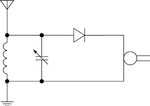Follow along with the video below to see how to install our site as a web app on your home screen.
Note: This feature may not be available in some browsers.
You can run a Fourier analysis to check this by yourself; for an audio signal one would expect a flat transfer input/output ratio at the frequency range above mentioned.
Ok, if you insist on a short answer:output singnal is in the audio frequency range or not?
Ok, if you insist on a short answer:
Yes, you are already getting an audio output.
Your questions are too broad, and it is not expected that you will learn from the answers got here. As said in another thread, you need to understando the fundamentals before doing something. A common FM and AM receviver has also the intermediary frequency at some stage, which turns easiest the tunning process. Your circuit is nothing else than containing part of the whole, not a demodulator as you claim, therefore instead of doing so, I would recommend you start with a known complete circuit took from somewhere and then inspecting its working at each point.can we design an FM/AM demodulator?
Your questions are too broad, and it is not expected that you will learn from the answers got here. As said in another thread, you need to understando the fundamentals before doing something. A common FM and AM receviver has also the intermediary frequency at some stage, which turns easiest the tunning process. Your circuit is nothing else than cantaining part of the whole, not a demodulator as you claim, therefore instead of ding so, I would recommend you start with a known complete circuit took from somewhere and then inspecting its working at each point.

Doesn't change much, Q1 Cbe is already working as a low pass.Why LPF cap is behind of Q1?
Can i move it front of Q1, because 2n4401 can't work above ~ 250 Mhz?
the rate of input pulses (frequency) determines how much voltage is allowed to build up across C6.
Brian.
Imagine you have a capacitor charging through a resistor, the voltage gradually rises until it reaches the supply voltage. Now imagine a switch that connects across the capacitor, each time it closes, the capacitor discharges and its voltage drops to zero.Can you explain how the rate of input frequency determines amount of voltage?
Low pass filters are not demodulators! There are some specific cases where a filter can be used to recover a voltage proportional to frequency (slope demodulation) but that isn't how your schematic works.That low pass filter can't demodulate higher frequencies?